- What is a Brand & Why is it Important?
- Elements of a Brand: Mission, Vision, and Values
- Types of Brands and their Significance
- Branding Strategies: Private, Multiproduct, and Mixed
- Brand Image and Its Impact on Perception
- Building a Strong Brand
- Frequently Asked Questions
- Understanding Brand Equity: Definition and Elements
- Importance of Brand Equity
- Evolution Of Brand Equity In The Digital Age
- Brand Equity in the Global Marketplace
- Measuring Brand Equity: Metrics & Methods
- Managing Brand Equity: Salient Elements
- Building & Managing Brand Equity: Best Practices
- The Future of Brand Equity
- Conclusion
- Frequently Asked Questions
- What is Brand Management?
- Importance of Brand Management
- Benefits of Effective Brand Management
- Principles of Brand Management
- Strategies for Successful Brand Management
- Brand Management vs. Marketing
- Conclusion: The Power of Brand Management
- Frequently Asked Questions
- Importance of Brand Image in Marketing
- Key Elements of a Successful Brand Image
- Brand Image vs. Brand Identity: Key Differences
- Measuring and Monitoring Brand Image
- Strategies for Maintaining and Enhancing Brand Image
- The Power of a Positive Brand Image
- FAQs
- What is Brand Awareness and its Importance?
- Benefits of Brand Awareness
- Brand Awareness Strategy: Some Tried & Tested Methods
- Some Creative Ways to Boost Brand Awareness
- Significance of Brand Awareness
- Conclusion
- Frequently Asked Questions
- Porter's 5 Forces Model: What Is It?
- Porter's 5 Forces Model: How To Use It?
- Common Barriers to Entry
- Evaluating Suppliers' Negotiating Power
- Understanding the Bargaining Power of Buyers
- Analyzing Threat of Substitute Products or Services
- Rivalry amongst Competitors (Old & New)
- Drawbacks of the Five Forces Model
- Conclusion
- Frequently Asked Questions
- How Well Do You Know Porter’s 5 Forces? Take A Quiz!
- What is Buying Motive?
- Types Of Buying Motives
- Importance Of Buying Motives
- Six Universal Buying Motives
- Identifying Buyer's Motives
- Utilizing Buying Motives In Sales
- Challenges In Interpreting Buying Motives
- Frequently Asked Questions (FAQs)
- 💸 Think You Know Buying Motives? Take A Quiz!
- Understanding the Elements and Importance of Brand Equity
- What are brand equity models?
- Comparing Keller's and Aaker's brand equity models
- Real-world examples of brand equity in action
- Strategies for building strong brand equity
- Key takeaways on brand equity models
- FAQs
- Mastered Brand Equity Models? Prove It!
- What Is Brand Positioning?
- The Importance of Brand Positioning for Businesses
- Creating A Brand Positioning Strategy: Step-By-Step Process
- Measuring the Success of Your Brand's Positioning
- Examples of Strong Brand Positioning in the Market
- Types of Brand Positioning Strategies
- Social Media Engagement: A Key Positioning Strategy
- What Makes a Good Brand Positioning Strategy?
- Conclusion
- Frequently Asked Questions
- Quick Quiz to Test Your Knowledge of Brand Positioning!
- Brand Personality: Definition & Importance
- How to Define Your Brand Personality?
- Choosing Your Brand Personality Attributes
- Dimensions of Brand Personality Framework: The Aaker Model
- Incorporating Core Values Into Your Brand Personality
- Examples of Brand Personalities in Action
- Conclusion
- Frequently Asked Questions
- Brand Personality Quiz– Let's Go!
- What is Brand Identity?
- What are the Key Components of Brand Identity?
- Importance & Benefits Of Brand Identity
- Importance of Unique Visual Elements in Brand Identity
- Communication Style and Tone of Voice in Brand Identity
- Steps on How to Create a Brand Identity
- Brand Identity Example- Coca-Cola
- Examples of Strong Brand Identities in Different Industries
- Consistency in Online and Offline Branding
- Conclusion
- Frequently Asked Questions (FAQs)
- Think You Know Brand Identity? Take A Quiz!
- Brand Identity Prism: Understanding The Concept
- Role Of Culture In Brand Identity Prism
- Brand Identity Prism: Visualizing The Sender & Receiver
- Benefits Of Brand Identity Prism
- Examples Of Brand Identity Prism In Action
- Brand Identity Prism: Key Takeaways
- Frequently Asked Questions
- Take This Brand Identity Prism Quiz!
- What is Market Segmentation?
- Importance of Market Segmentation
- The Market Segmentation Process
- Types of Market Segmentation
- Common Challenges in Implementing Market Segmentation
- Overcoming Challenges in Market Segmentation
- Conclusion: Understanding The Impact
- Frequently Asked Questions (FAQs)
- Test Your Market Segmentation Knowledge– Take This Quiz!
- What is Brand Loyalty? Meaning & Significance
- Characteristics of Brand Loyalty
- Measuring and Tracking Brand Loyalty
- Importance of Brand Loyalty for Companies
- Brand Loyalty Examples and Types
- Strategies for Building Brand Loyalty
- Differentiating Brand Loyalty from Customer Loyalty
- Conclusion: The Power and Importance of Brand Loyalty
- Frequently Asked Questions
- Think You Know Brand Loyalty? Take A Quiz!
- Brand Extension Meaning
- Brand Extension Types
- Understanding Brand Line Extension vs. Brand Extension
- The Impact and Potential of Brand Extension
- Successful and Unsuccessful Brand Extensions Examples
- Summing Up
- Frequently Asked Questions
- Quiz– Test Your Brand Extension!
- Step-by-step guide on how to build a brand from scratch
- Benefits of a Strong Brand
- Examining Successful Brand-Building Examples
- Summing up
- Frequently Asked Questions
- Know How to Build a Brand? Prove it With This Quiz!
- What is Marketing Mix?
- Understanding the 4 Ps of Marketing
- The Seven Ps of Marketing
- Implementing the Marketing Mix in Business
- Amul: Example of Successful Marketing Mix Implementation
- Exploring Alternative Marketing Mix Models
- Conclusion
- Frequently Asked Questions (FAQs)
- Mastered the Marketing Mix! Test Your Knowledge Now
- Defining Brand Value and its Importance
- Measuring Brand Value
- Factors that Make a Brand Valuable to Customers
- Examples of Brand Value from Real World
- Brand Value Versus Brand Equity
- The Impact of Brand Value on Business Marketing Strategies
- Conclusion: The Significance of Brand Value
- Frequently Asked Questions
- How Much Do You Know About Brand Value? Take This Quiz!
- Definition Of Co-Branding
- Different Types Of Co-Branding
- Benefits & Advantages Of Co-Branding
- Strategies For Successful Co-Branding Partnerships
- Notable Successful Co-Branding Examples
- Factors Influencing Co-Branding Success
- Frequently Asked Questions (FAQs)
- Co-Branding Quiz: Test Your Expertise!
- What is a Target Market?
- Importance of Target Market: Why Do We Need It?
- Types of Target Market
- The Target Marketing Process
- Primary Research for Target Markets
- Leveraging Target Market Segmentation for Sales
- Conclusion
- Frequently Asked Questions (FAQs)
- 🎯 Do You Know Your Target Market? Take the Quiz!
- Importance of Understanding Consumer Decisions
- Traditional vs Contemporary Consumer Behaviour Model
- Traditional Models of Consumer Behaviour
- Learning Model of Consumer Behaviour
- Psychoanalytical Model of Consumer Behaviour
- Sociological Model of Consumer Behaviour
- Economic Model of Consumer Behaviour
- Contemporary Models of Consumer Behaviour
- EKB Model of Consumer Behaviour
- Black Box Model of Consumer Behaviour (Stimulus-Response Consumer Behaviour Model)
- Howard Sheth Model of Consumer Behaviour
- Hawkins-Stern Model of Consumer Behavior
- Webster and Wind Model
- Nicosia Model of Consumer Behaviour
- How to Select a Consumer Behaviour Model?
- Final Remarks
- Frequently Asked Questions
- 🛍️ Consumer Behavior Models Quiz: Test Your Knowledge!
- What is a Consumer?: Definition & Role
- The Evolution of the Term "Consumer"
- Consumer Behavior
- Different Types of Consumers
- Consumers' Motivation for Buying
- Relationship Between Businesses and Consumers
- Consumer Rights in India
- Current Challenges for Consumers
- The Future of Consumers in a Digital Age
- Final Remarks
- Frequently Asked Questions (FAQs)
- 🛍️ Consumer or Customer? Test Your Knowledge!
- What is a Market Structure?
- Types of Market Structures
- How Markets Work
- Significance of Different Types of Market
- Summing Up
- Frequently Asked Questions
- 🏪 Market Structures 101: Take the Quiz!
- Understanding the Concept of Corporate Branding
- Importance and Advantages of Corporate Branding
- Researching Competitor Brands
- Implementing Effective Corporate Branding Strategies
- Successful Corporate Branding Examples: Alphabet, Walmart & SAP
- Impact and Success of Corporate Branding
- Conclusion
- Frequently Asked Questions
- 🏢 Corporate Branding Quiz: Test Your Knowledge!
- Perception Management: Meaning & Importance
- Process Of Perception Management
- Influencing & Shaping Perceptions
- Strategies For Perception Management
- Technology In Perception Management
- Branding & Control In Perception Management
- Customer Feedback For Perception Improvement
- Frequently Asked Questions (FAQs)
- 🧠 Perception Management Quiz: How Well Do You Know It?
- Definition & Importance Of Target Marketing
- Advantages & Disadvantages Of Target Marketing Strategies
- Examples Of Target Marketing Strategies
- Creating An Effective Target Market Strategy
- Segmentation: Key To Targeted Marketing
- Utilizing Social Media For Targeted Marketing
- Frequently Asked Questions ( FAQs)
- 🎯 Target Marketing Strategies Quiz: Test Your Knowledge!
- Definition and Significance of Brand Association
- Brand Association Types
- Successful Brand Association Examples
- Strategies for Building Strong Brand Associations
- Overcoming Negative Brand Associations
- Conclusion: Harnessing the Power of Brand Association
- Frequently Asked Questions
- 🔗 Brand Association Quiz: Check Your Brand Knowledge!
- What is Product Positioning?
- Importance Of Product Positioning in Marketing
- Difference between Product Positioning and Brand Positioning
- Types Of Product Positioning
- Main Components Of Product Positioning
- Successful Product Positioning Strategies
- Understanding the Product Positioning Process
- Examples Of Effective Product Positioning
- Conclusion
- Frequently Asked Questions (FAQs)
- 🔥 Product Positioning Quiz: Test Your Marketing Smarts!
- How do we define niche market?
- Strategies To Find Your Niche Market
- 7 Examples Of Niche Markets
- Benefits Of Targeting A Niche Market
- Testing Your Product Or Service For Niche Market
- Conclusion
- Niche Market: Frequently Asked Questions (FAQs)
- 🎯 Niche Market Quiz: Test Your Knowledge!
- Importance Of STP In Marketing
- Understanding STP in Marketing Step-by-Step
- Process Of Implementing STP In Marketing
- Examples Of Successful STP Strategies
- Conducting An STP Marketing Analysis
- Choosing Your Marketing Mix
- Strategies For Targeting the Right Audience
- Conclusion
- Frequently Asked Questions (FAQs)
- 🔍 STP in Marketing Quiz: Test Your Knowledge!
- Sales and Marketing: Understanding the Core Concepts
- Key Differences Between Sales and Marketing
- Types of Marketing
- Types of Sales
- Power of Synergy: Sales and Marketing Alignment (Smarketing)
- Frequently Asked Questions (FAQs)
- Definition Of Customer Satisfaction
- Importance Of Customer Satisfaction
- Strategies For Effective Customer Satisfaction
- Measuring Customer Satisfaction
- Customer Satisfaction in Marketing & Sales
- Frequently Asked Questions (FAQs)
- 🎯 Customer Satisfaction Quiz: Are You an Expert?
- Customer Delight Meaning
- Benefits of Customer Delight
- Customer Satisfaction Vs Customer Delight
- Strategies With Customer Delight Examples
- How to Measuring the Impact Of Customer Delight?
- Customer Delight Examples - 3 instances by big brands that won hearts
- Common Mistakes In Customer Delight
- Conclusion
- Frequently Asked Questions (FAQs)
- 🌟 Customer Delight Quiz: Can You Ace It?
- What is a Marketing Plan?
- Types Of Marketing Plan
- What are the Key Components of a Marketing Plan?
- Steps for Effective Marketing Planning
- Crafting Your SEO Content Strategy
- Budgeting & Resource Allocation
- Identifying & Analyzing Competition
- Measuring Success with KPIs
- Importance of Flexibility in Marketing Planning
- Challenges of Marketing Plan
- Marketing Plan vs Business Plan
- Conclusion
- Frequently Asked Questions (FAQs)
- 📊 Marketing Planning Quiz: Test Your Knowledge!
- What is Marketing Control?
- Types of Marketing Control (with Examples)
- Annual Plan Marketing Control
- Profitability Marketing Control
- Efficiency Marketing Control
- Strategic Marketing Control
- Process of Marketing Control
- Techniques Used in Marketing Control
- Frequently Asked Questions
Market Segmentation: What It Is & How Does It Drive Growth?
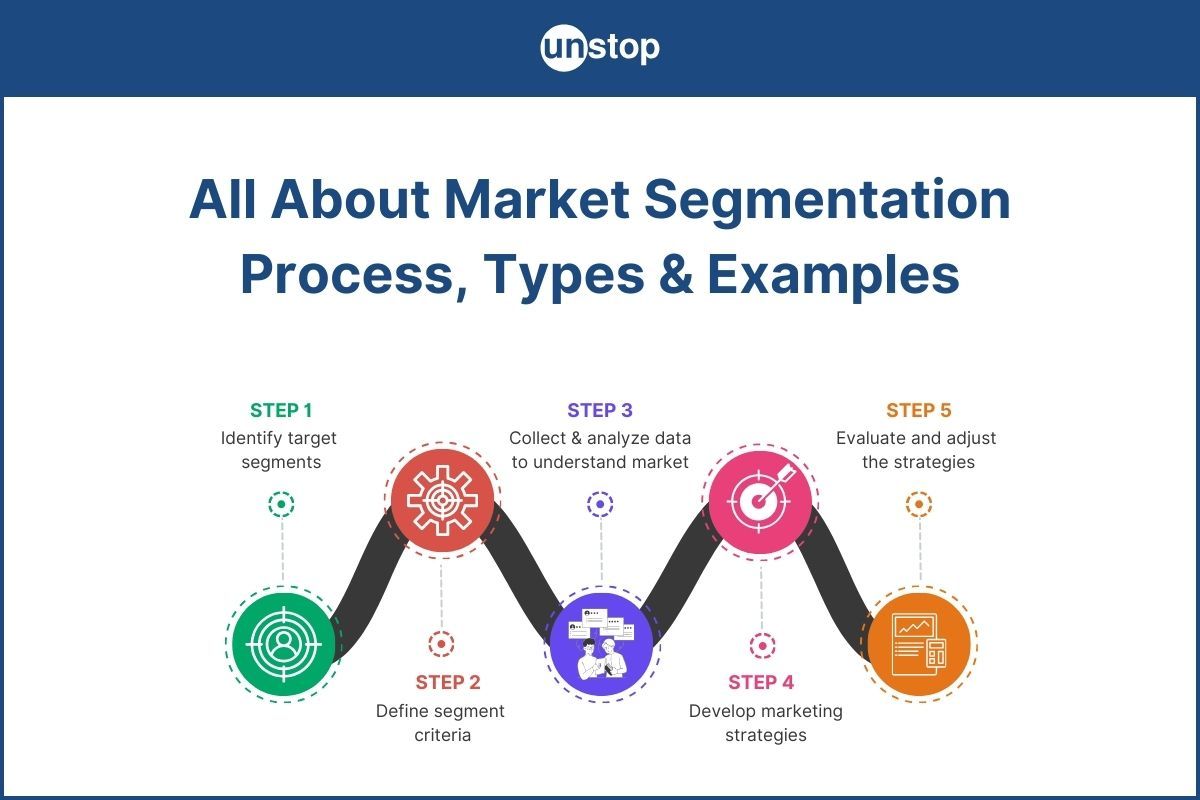
Imagine you're at a theme park, like Disneyland Park, ready to embark on a thrilling roller coaster ride. Now, think about all the different people around you. Some are seeking the fastest roller coasters, while others might prefer gentler rides. And some are just there for the delicious snacks.
What if the theme park treated everyone the same - offering just one type of ride, food, or experience? It would be a disaster, right? The key to avoiding this - market segmentation.
What is Market Segmentation?
Market segmentation is the ace card up companies’ sleeves, helping them better understand their customers better and deliver exactly what they want.
In the example above, the theme park organizers understand that not everyone wants the same thing. So, they divide their target market into different segments. They create separate areas for thrill-seekers, families with young children, and food lovers. By doing this, they can cater to the specific needs and preferences of each group.
Market segmentation is all about tailoring the experience to different groups. By dividing a broad target market into smaller, more manageable segments, companies can identify distinct customer groups with specific needs and preferences. This enables them to develop targeted marketing campaigns that resonate with each segment, leading to increased customer satisfaction and higher profits.
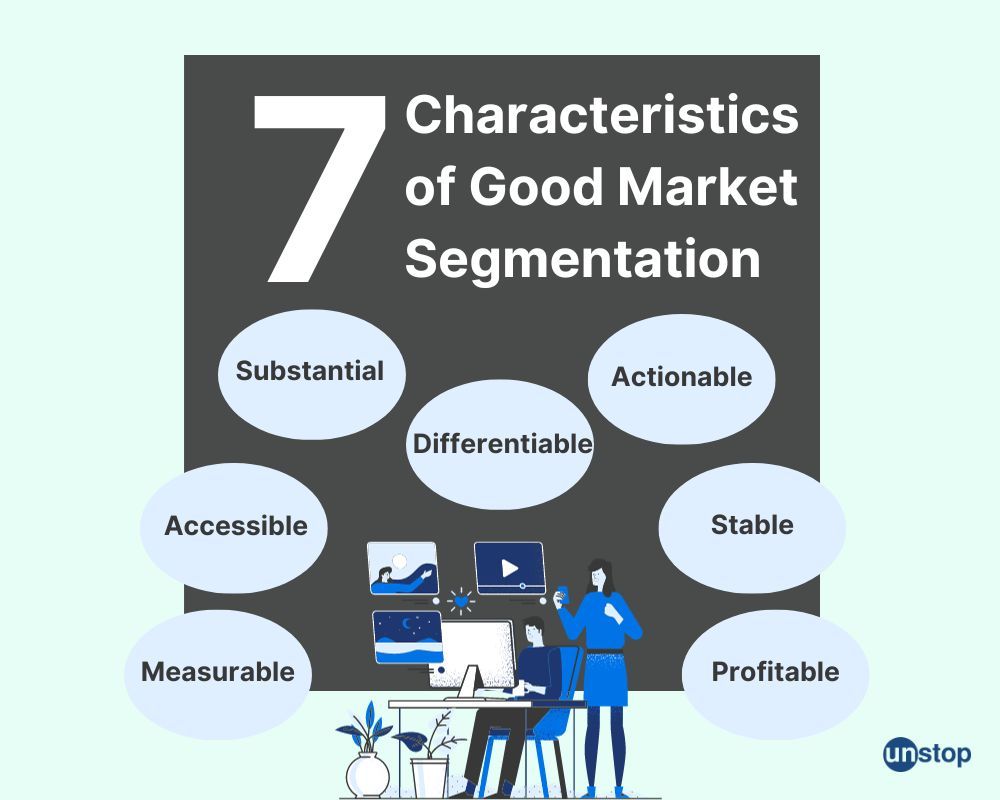
Characteristics of a Good Market Segmentation
A good market segmentation has several key characteristics that make it effective in targeting and reaching the desired consumer base.
- Measurable: A good market segmentation should be easily measurable, allowing businesses to quantify the size and potential of each segment. This helps evaluate the market opportunity and allocate resources effectively.
- Accessible: The segments should be accessible through specific marketing channels and mediums. It should be possible to reach and communicate with the target audience through advertising, distribution channels, or other means.
- Substantial: The segments should be large enough to be profitable and worth targeting. A market segment with a small customer base may not be financially viable for businesses to invest in.
- Differentiable: Each segment should be distinct from one another in terms of their needs, preferences, or behaviors. This allows businesses to tailor their marketing strategies and offerings to meet the specific requirements of each segment.
- Actionable: A good market segmentation should provide actionable insights that businesses can use to develop targeted marketing campaigns and strategies. It should enable businesses to make informed decisions on product development, pricing, promotion, and distribution.
- Stable: The segments should be relatively stable over time to ensure the long-term effectiveness of marketing efforts. If the segments are constantly changing or evolving, it can make it difficult for businesses to maintain a consistent marketing strategy.
- Profitable: Ultimately, a good market segmentation should be profitable. The segments should have the potential to generate sufficient revenue and profit for businesses. It is important to evaluate the profitability of each segment and prioritize those that offer the highest potential return on investment.
Importance of Market Segmentation
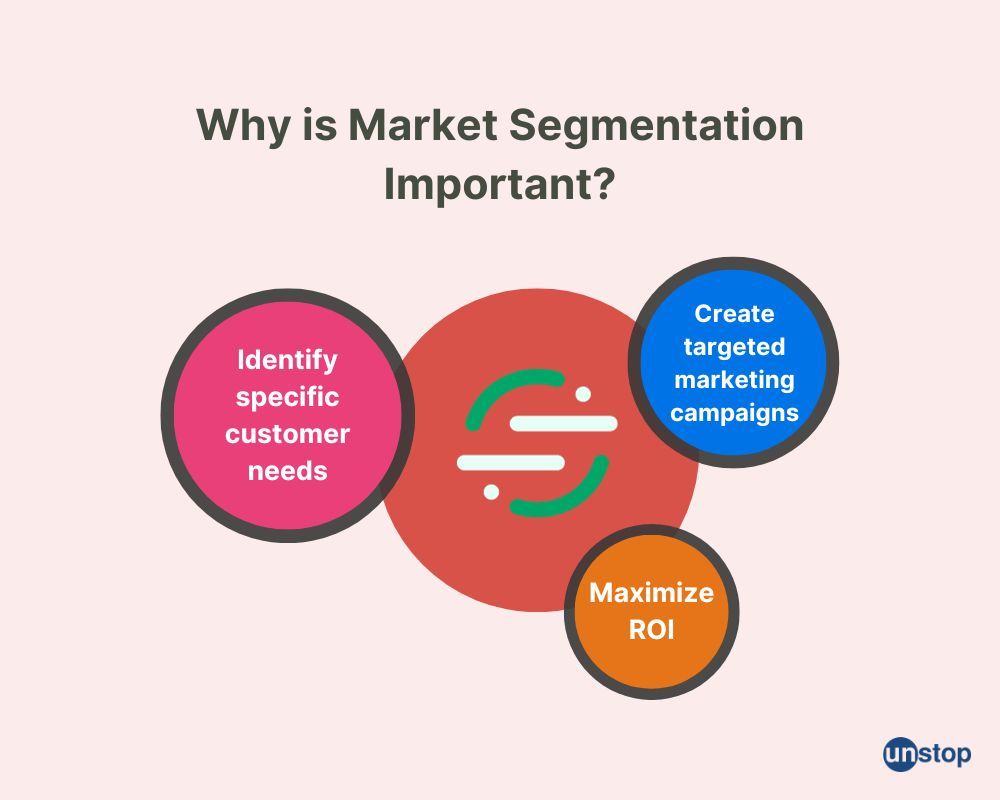
Here’s why market segmentation is important:
Identify Specific Customer Needs and Preferences
One of the key benefits of market segmentation is its ability to provide businesses with valuable insights into the diverse needs and preferences of different customer groups. By analyzing factors such as demographics, psychographics, behaviors, and buying patterns, companies can gain a deeper understanding of what drives their customers' purchasing decisions.
For example, a clothing retailer may discover through market segmentation that one segment consists primarily of young adults who value trendy fashion at affordable prices. Armed with this knowledge, the retailer can create targeted marketing campaigns that showcase the latest fashion trends at competitive prices, appealing directly to this specific segment's desires.
Create Targeted Marketing Campaigns
With market segmentation, businesses can develop highly targeted marketing campaigns that resonate with their audience on a personal level. Instead of employing a one-size-fits-all approach, they can tailor their messaging and communication channels to suit each segment's unique characteristics.
For instance, an online beauty store might identify two distinct segments: skincare enthusiasts who prioritize natural ingredients and busy professionals seeking quick beauty solutions. To cater to these segments effectively, the store could create separate email newsletters featuring relevant product recommendations and tips tailored specifically to each group's interests and lifestyles.
Maximize ROI
By focusing on the most profitable segments identified through market segmentation analysis, businesses can optimize their resources efficiently. Instead of spreading themselves thin by targeting a broad audience with limited impact, they can concentrate their efforts where they are most likely to yield positive results.
This focused approach allows companies to allocate their marketing budgets strategically for maximum return on investment (ROI). They can invest in channels that have proven effective in reaching specific segments while avoiding unnecessary spending on less responsive segments.
Competitive advantage
By utilizing market segmentation strategies effectively, businesses can differentiate themselves from competitors by offering tailored solutions that meet the unique needs of specific customer segments.
Market segmentation can even help businesses identify new market opportunities. By analyzing customer segments, companies may uncover untapped niches or unmet needs that they can address with innovative products or services.
The Market Segmentation Process
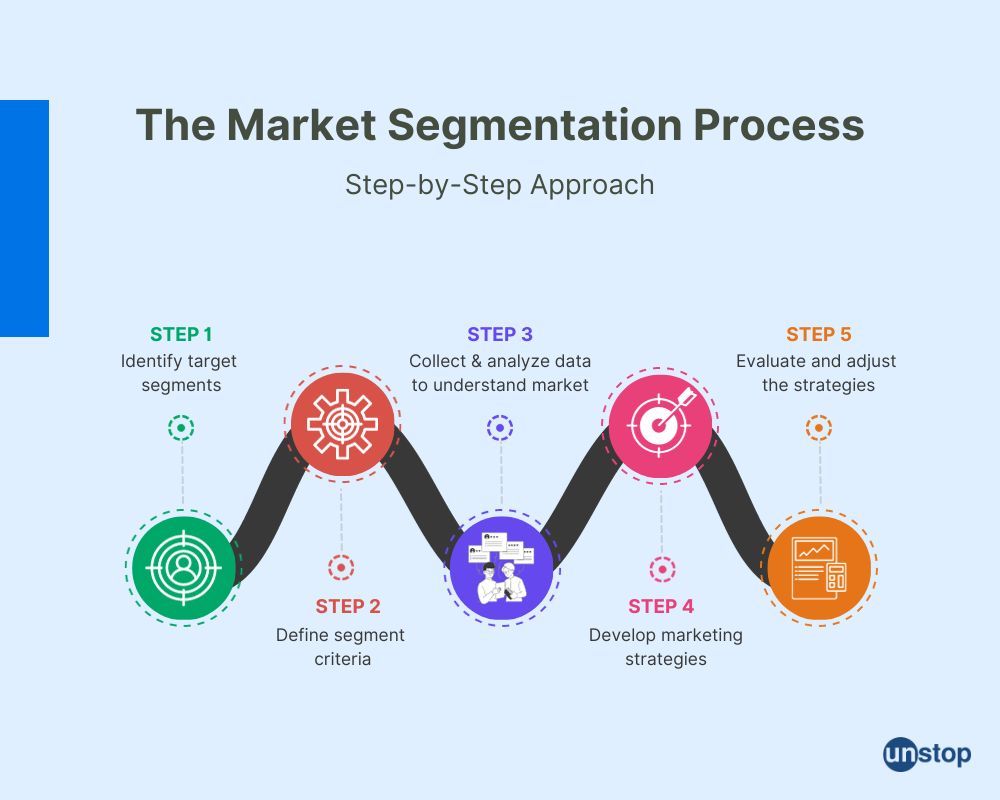
Here’s a step-by-step approach to the market segmentation process:
Identifying Target Segments
The first step in market segmentation is identifying the target segments that align with your business objectives. This involves conducting thorough research to gather data about potential customers' demographics, psychographics, geographic location, buying motives and behaviour. By analyzing this information, you can identify which segments are most likely to be interested in your offerings.
Defining Segment Criteria
Once you have identified potential target segments, the next step is defining specific criteria that will help you categorize customers into these segments. This could include factors such as age, gender, income level, lifestyle choices, interests, or purchasing habits. Defining clear segment criteria ensures that each segment is distinct and allows for effective customization of marketing efforts.
Collecting and Analyzing Data to Understand the Market
To further refine your understanding of each segment and make informed decisions about targeting strategies, collecting relevant data is essential. This can be done through various methods such as surveys, focus groups, interviews, or analyzing existing customer data.
Once you have gathered the necessary data from different sources, it's time to analyze it thoroughly. This involves examining patterns and trends within each segment to identify commonalities and differences among customers. By doing so, you can gain deeper insights into their needs and preferences and develop targeted messaging that resonates with each segment.
Developing Marketing Strategies
Based on the analysis of customer data and insights gained from segmentation research; businesses can now develop tailored marketing strategies for each target segment. These strategies should focus on delivering personalized messages, products, and experiences that address the specific needs and desires of each segment. By doing so, businesses can establish a strong connection with their target audience and increase the chances of conversion.
Evaluating and Adjusting
Market segmentation is an ongoing process that requires continuous evaluation and adjustment. Businesses need to monitor the effectiveness of their marketing strategies for each segment and make necessary changes based on customer feedback and market dynamics. This ensures that businesses stay relevant and responsive to evolving customer needs.
Types of Market Segmentation
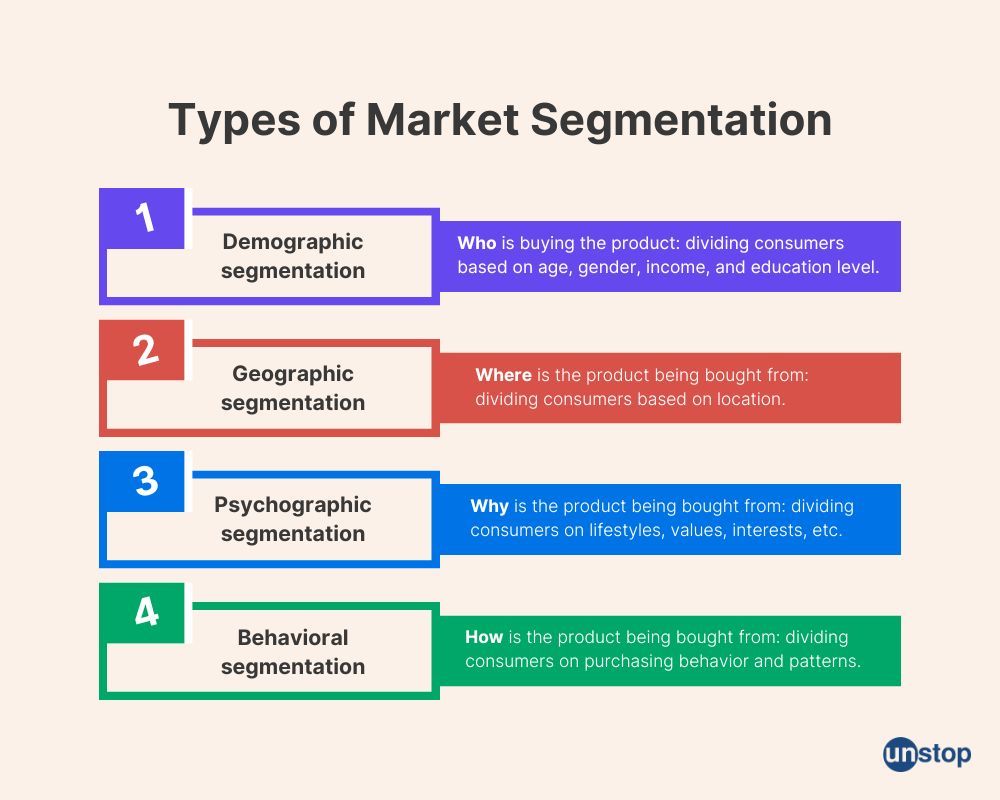
There are four major types of market segmentation that businesses commonly use:
Demographic segmentation
It involves dividing consumers based on factors such as age, gender, income, and education level. This helps businesses understand the specific needs and preferences of different demographic groups. For example, a company may target a younger demographic with trendy and affordable products, while focusing on higher-income individuals with luxury items.
Demographic segmentation answers the question - who is buying the product?
Geographic segmentation
It involves dividing consumers based on their location. This can be done on a local, regional, national, or international level. By understanding the unique characteristics and preferences of consumers in different geographic areas, businesses can create targeted marketing campaigns. For instance, a company might promote products suitable for warm climates in tropical regions, while emphasizing cold-weather products in colder areas.
Geographic segmentation answers the question - where is the product being bought from?
Psychographic segmentation
It involves categorizing consumers based on their lifestyles, interests, values, and personality traits. This type of segmentation helps businesses understand the motivations and behaviors of their target audience. For example, a company may target environmentally conscious consumers by promoting eco-friendly products and sustainable practices.
Psychographic segmentation answers the question - why is the product being bought?
Behavioral segmentation
It involves categorizing consumers based on their purchasing behavior and patterns. This includes factors such as brand loyalty, usage rate, and buying habits. By analyzing consumer behavior, businesses can identify opportunities to tailor their marketing efforts. For instance, a company may target frequent buyers with loyalty programs or offer discounts to customers who have shown interest in a particular product.
Behavioral segmentation segmentation answers the question - how is the product being bought?
Firmographic Segmentation
Apart from these four types of market segmentation, there is also firmographic segmentation. It is primarily used in business-to-business (B2B) marketing. It involves categorizing customers based on criteria such as industry type, company size, and location. By understanding the unique needs and requirements of different businesses, companies can develop targeted marketing strategies. For example, a software company may focus on providing solutions specifically designed for healthcare organizations or target small businesses with affordable pricing plans.
Examples of Market Segmentation
Here are some common examples of market segmentation:
- An ice cream company might promote different flavors based on regional preferences. They could offer tropical fruit flavors in warmer areas and rich chocolate flavors in cooler regions. This is an example of geographic segmentation.
- A fitness brand might focus on health-conscious individuals who prioritize physical well-being by emphasizing the performance benefits of their products. This is an example of psychographic segmentation.
- An e-commerce platform might segment customers based on their past purchase history to recommend similar products or offer personalized discounts. This is an example of behavioral segmentation.
Remember, these are just a few examples of market segmentation strategies used by businesses across various industries. The key is to understand your target audience thoroughly and develop strategies that resonate with them.
Common Challenges in Implementing Market Segmentation
Implementing market segmentation can be a tricky task that comes with its fair share of challenges. Let's take a closer look at some of the common problems, mistakes, and efforts that marketers face when implementing market segmentation.
Lack of accurate data or insufficient market research
One of the main challenges in implementing market segmentation is the lack of accurate data or insufficient market research. Without proper data, it becomes difficult to identify and understand different customer segments effectively. Accurate data provides valuable insights into consumer behavior, preferences, and demographics, allowing marketers to create targeted marketing strategies. Insufficient market research can lead to ineffective segmentation efforts and hinder the success of marketing campaigns.
Overlapping segments
Another challenge in market segmentation is the possibility of overlapping segments. When segments overlap, it can create confusion and make it challenging for marketers to allocate resources efficiently. Overlapping segments may result from inadequate analysis or improper targeting criteria. For example, if two segments are identified based on similar characteristics but have different needs or preferences, targeting them with the same marketing strategy may not yield optimal results. It is crucial for marketers to carefully analyze their target audience and ensure that there is minimal overlap between segments.
Complexity
Adapting marketing strategies for multiple segments can be a complex process that requires careful planning and coordination. Each segment may have unique needs, preferences, and communication channels that need to be addressed individually. Marketers must develop tailored messaging and positioning strategies for each segment while maintaining consistency across all marketing efforts. This requires effective coordination between different teams within an organization to ensure seamless execution.
Overcoming Challenges in Market Segmentation
To overcome these challenges, marketers should:
- Invest in thorough market research: Conducting comprehensive market research helps gather accurate data about consumer behavior, preferences, and demographics.
- Utilize advanced analytics tools: Leveraging advanced analytics tools enables marketers to analyze data effectively and identify meaningful insights for segmentation.
- Refine targeting criteria: By refining targeting criteria, marketers can ensure that segments are distinct and do not overlap, allowing for more effective resource allocation.
- Develop tailored marketing strategies: Developing tailored marketing strategies for each segment helps address their unique needs and preferences, increasing the chances of success.
- Foster collaboration within the organization: Encouraging collaboration between different teams within an organization ensures smooth coordination and consistent messaging across all marketing efforts.
Implementing market segmentation successfully requires overcoming various challenges. By addressing these challenges head-on and employing strategic approaches, marketers can enhance their segmentation efforts and achieve better results in reaching their target audience.
Conclusion: Understanding The Impact
Effective market segmentation has a significant impact on various aspects of a business. By dividing the market into distinct groups based on specific characteristics, businesses can better understand their customers and tailor their marketing efforts accordingly.
When businesses successfully implement market segmentation strategies, they demonstrate a deep understanding of their customers' needs and wants, which fosters a sense of loyalty among customers. As a result, loyal customers are more likely to stay with the brand over time and become advocates for the business within their social circles.
When businesses invest in understanding market potential through segmentation analysis, they gain valuable insights into consumer demographics such as income levels and buying power. Armed with this information, businesses can develop pricing strategies that align with each segment's financial capabilities, maximizing revenue potential.
Frequently Asked Questions (FAQs)
1. How does market segmentation help improve customer satisfaction?
By segmenting the market and understanding customers' unique needs within each segment, businesses can create tailored products or services that better meet those needs. This leads to increased customer satisfaction as customers feel understood and catered to on an individual level.
2. What are some effective ways to conduct behavioral segmentation?
Behavioral segmentation involves analyzing customers' actions, such as purchasing patterns or product usage habits. To effectively conduct behavioral segmentation, businesses can use data analytics tools to track customer behavior online or offline and gather insights that inform their marketing strategies.
3. Can you provide an example of psychographic segmentation?
Psychographic segmentation categorizes consumers based on their attitudes, values, interests, or lifestyles. An example would be a fitness apparel company targeting health-conscious individuals who value sustainability by offering eco-friendly workout clothing made from recycled materials.
4. How can firms overcome challenges in implementing market segmentation?
Some common challenges include collecting accurate data for segment identification or facing resistance from employees who may be resistant to change. Firms can overcome these challenges by investing in market research, training employees on the benefits of segmentation, and gradually implementing changes to ensure a smooth transition.
5. What are the advantages of generational segmentation?
Generational segmentation allows businesses to tailor their marketing strategies to different age groups with unique characteristics and preferences. This approach helps companies effectively communicate and engage with each generation, leading to increased brand loyalty and higher conversion rates.
Test Your Market Segmentation Knowledge– Take This Quiz!
You may also be interested in the following:
- Brand Management: Definition, Strategies, Principles & Benefits Explained
- Brand Equity: Definition, Importance, Key Elements & Examples
- Retail Marketing: Types, Strategies And Examples Of Successful Market Players!
- Brand Identity: A Definitive Guide For Understanding This Marketing Concept
- MBA in Marketing: Eligibility, Syllabus, Careers Scope & More!
Alekhya Chakrabarty is a father, a doodler, a trivia buff, a sports fanatic and a lifelong student of marketing. Alekhya is the VP of Marketing & Growth at Unstop, the engagement and hiring platform which connects students and graduates with opportunities. He has over a decade and a half of experience in driving revenue and building brands with the likes of Nestle, HUL and ITC. He is an alumnus of IMT Ghaziabad and in his last stint he was leading the marketing function at Sunstone, a higher education startup. Alekhya has been recognised as a ‘Top Voice’ on LinkedIn for Digital Marketing & Brand Management. He runs a marketing podcast titled East India Marketing Company to drive conversations around growth, content, culture and commerce.
Login to continue reading
And access exclusive content, personalized recommendations, and career-boosting opportunities.
Subscribe
to our newsletter
















Comments
Add comment